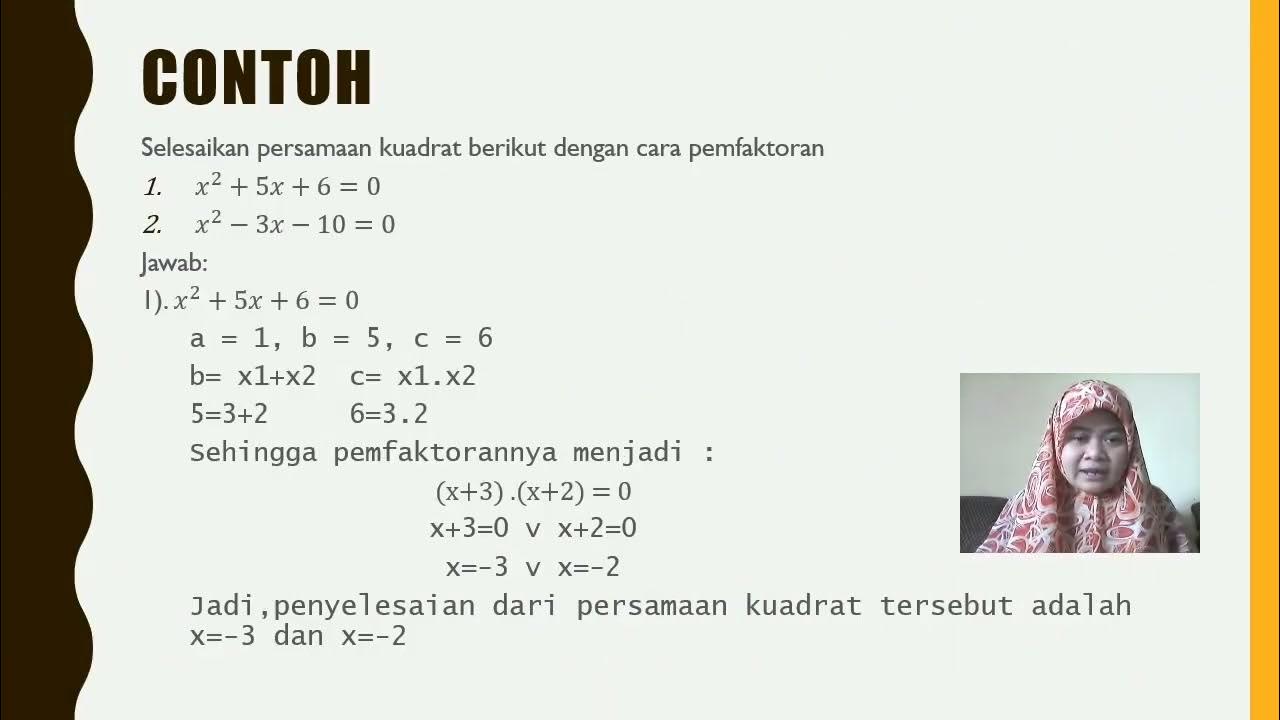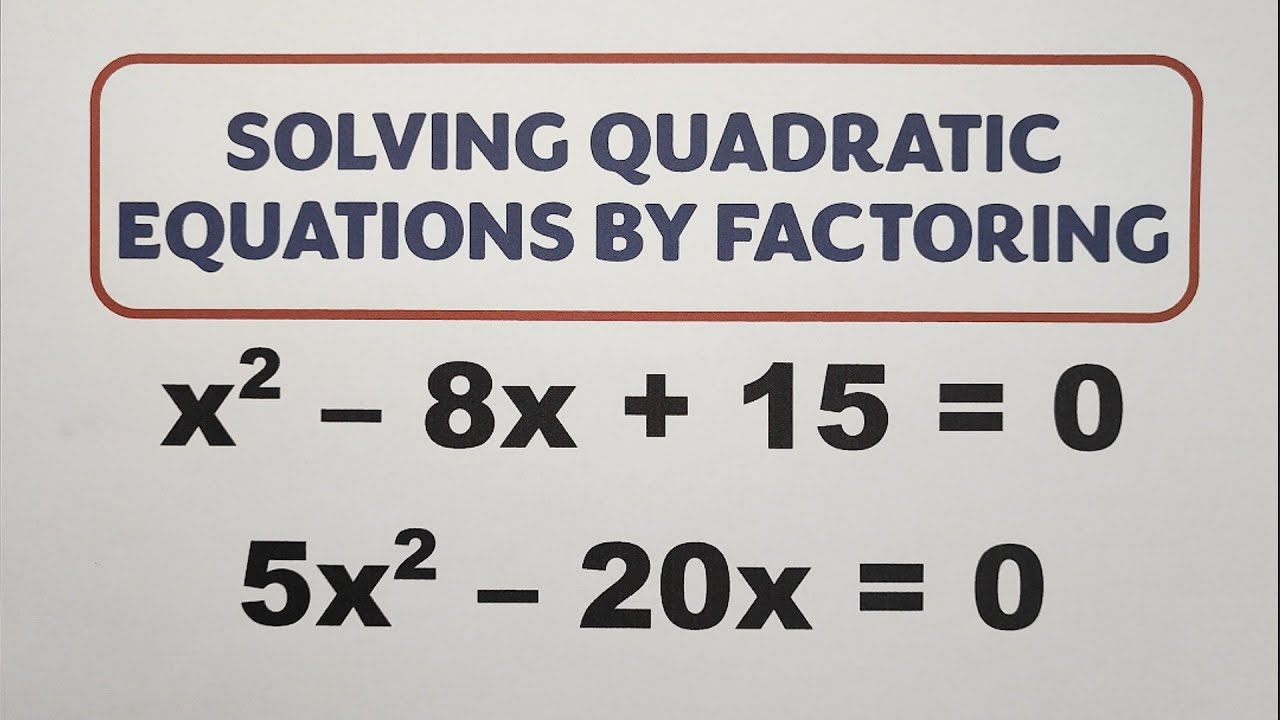Word Problems - Solving Quadratic Equations by Factoring
Summary
TLDRThis video tutorial focuses on solving word problems involving quadratic equations, specifically using the method of factoring. It demonstrates how to approach problems involving areas of rectangles by setting up equations based on the given relationships between length, width, and area. Through step-by-step explanations, viewers learn how to label variables, set up quadratic equations, and solve them by factoring. The tutorial covers multiple examples, helping learners understand how to solve for unknown dimensions of rectangles, reject invalid solutions, and use factoring to find the correct dimensions.
Takeaways
- 😀 Use the formula for area (Length × Width) to solve for unknown dimensions in rectangle word problems.
- 😀 When the length is given in terms of the width (e.g., 6 cm less than triple the width), express the length as a function of the width (L = 3W - 6).
- 😀 Create a visual diagram to help organize information and understand the relationship between length, width, and area.
- 😀 To set up the quadratic equation, multiply the length and width expressions and set it equal to the given area value.
- 😀 After setting up the equation, simplify and arrange it into standard quadratic form (e.g., 3W^2 - 6W - 72 = 0).
- 😀 Factor the quadratic equation, and solve for the width (W) by setting each factor equal to zero.
- 😀 Reject negative solutions for dimensions like width and length, as these cannot be physically valid.
- 😀 Once the width is found, substitute it back into the length equation to calculate the corresponding length.
- 😀 Use factoring as the method for solving quadratic equations, and ensure the equation is set equal to zero before factoring.
- 😀 Apply the same steps for word problems with added complexities, such as the addition of a uniform border around a rectangle.
- 😀 When a new rectangle's area is a multiple of the original (e.g., doubled or tripled), set up an equation with the new area and solve using the same quadratic techniques.
Q & A
What is the first step in solving the given word problem involving a rectangle?
-The first step is to identify the known information and create labels. For example, the area of the rectangle is given as 72 square centimeters, and the length is described in terms of the width.
How is the length of the rectangle described in the first problem?
-The length of the rectangle is described as 6 centimeters less than triple the width. This is expressed as the equation: length = 3W - 6, where W represents the width.
What equation is used to solve for the width and length of the rectangle in the first problem?
-The equation used is the area formula: length × width = area. After substituting the expressions for length and area, we get 3W^2 - 6W = 72, which simplifies to a quadratic equation.
How is the quadratic equation set up to be solved?
-To solve the quadratic equation, it must be set equal to zero. This is done by subtracting 72 from both sides, leading to 3W^2 - 6W - 72 = 0.
What factoring method is used to solve the quadratic equation?
-The factoring method used is the 'add-multiply' method, where factors of the quadratic equation are found. The factored form is (W - 6)(W + 4) = 0.
Why is W = -4 rejected as a solution for the width?
-W = -4 is rejected because the width of a rectangle cannot be negative. Therefore, only the positive solution, W = 6, is accepted.
After finding the width, how do you find the length of the rectangle?
-The length is found by substituting the value of W into the expression for length: length = 3W - 6. Substituting W = 6 gives length = 12.
What is the significance of the uniform border added in the second problem?
-The uniform border added to the rectangle increases both the width and length by the same amount, represented by 'X'. This changes the dimensions of the new rectangle, which is key to solving the problem.
How do you find the new width and length in the second problem?
-The new width is expressed as 2X + 6, and the new length is expressed as 2X + 20, where X represents the amount the border extends on each side.
What equation is set up to solve for the value of X in the second problem?
-The equation set up is the area formula for the new rectangle: (2X + 6)(2X + 20) = 240, which is then expanded and simplified into a quadratic equation.
What is the value of X in the second problem, and how do you calculate the new dimensions?
-The value of X is 2, which is determined by solving the quadratic equation. Substituting X = 2 into the expressions for the new width and length gives a new width of 10 inches and a new length of 24 inches.
In the third problem, how is the new area related to the original area?
-In the third problem, the new area is described as double the original area. The original area is 120 square inches, so the new area is 240 square inches.
What is the key to solving the fourth problem about the new rectangle dimensions?
-The key is recognizing that the new area is triple the original area, so the new area is 96 square inches. From there, similar steps of labeling, creating expressions, and solving a quadratic equation are used.
Outlines

此内容仅限付费用户访问。 请升级后访问。
立即升级Mindmap

此内容仅限付费用户访问。 请升级后访问。
立即升级Keywords

此内容仅限付费用户访问。 请升级后访问。
立即升级Highlights

此内容仅限付费用户访问。 请升级后访问。
立即升级Transcripts

此内容仅限付费用户访问。 请升级后访问。
立即升级5.0 / 5 (0 votes)






